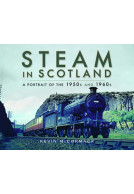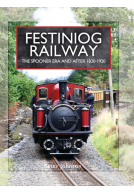The Chester and Holyhead Railway (ePub)
A New History
Imprint: Pen & Sword Transport
File Size: 88.6 MB (.epub)
Illustrations: 100 colour & black and white illustrations & maps
ISBN: 9781526749208
Published: 5th November 2021
| Other formats available - Buy the Hardback and get the eBook for £1.99! | Price |
|---|---|
| The Chester and Holyhead Railway Hardback Add to Basket | £22.50 |
The Chester and Holyhead Railway is one of Britain’s most important main line routes, connecting London with mainland north Wales, and the Isle of Anglesey.
The line was completed in 1850 under the direction of Robert Stephenson whose work included the famous tubular bridges that cross the river at Conwy and the Menai Straits near Bangor, the latter one destroyed by fire in 1970.
The line was built primarily to support British rule in Ireland but was later instrumental in developing north Wales as a major tourist destination. Today the railway remains an important part of the Welsh and UK networks, providing trains that link north Wales with Cardiff and major English cities, as well as connecting with ferry services to Ireland.
Book review as featured in
ICE Panel for Historical Engineering Works Newsletter
"The work includes excellent end notes, index and bibliography. As a purchase recommendation it is a little specialist but if the subject material is within your sphere of interest, it is a well-presented book and value for money."
Journal, September/ October 2022
The book provides a thorough overview of the line and its key role in the area’s development and will be of special value to those with an interest in the history of railway development in the area.
Rail Advert
4.7 out of 5
Read the Full Review Here
In the 19th century, the coming of a railway to any area was invariably an important event, but some lines had a particular impact. The Chester & Holyhead was such a line, with a history that sets it apart. Its primary purpose was to link Dublin with London and it played a key role in the often trouble relationship between the England and Ireland following the 1801 Act of Union that brought Ireland into the United Kingdom. The priority was to make the journey as short and rapid as possible, not least for the transport of mail in an age when it was the primary means of communication.
Ffestiniog Railway Magazine
As is well known to students of the FR’s early history, there were two competing rail routes proposed for the Irish Mail, one along the north coast to Holyhead, the other across mid-Wales, then through Portmadoc and on to Porth Dinllaen. This book tells how the former route became preferred, and went on also to play a major role in the development of the North Wales coast as a holiday destination in Victorian times, thus reshaping the region in many ways.
The book doesn’t provide a mass of technical information about engines, structures, operating practices and performance, although these are mentioned when relevant to the social, political, economic, environmental and cultural issues discussed in the chapters. Also covered is the history of the railway steamship operations linking Holyhead with Dublin. It is thus a book for those with an interest in the railway within the larger social and historical context.
For the author, this book represents the culmination of a lifetime’s interest in the line. Despite being a complex subject it is written in a style that is easy to read and pleasing. It is illustrated with sufficient historic photographs, together with modern shots to amply convey its unique character, all reproduced to the publisher’s usual high standard. It is thoroughly recommended, and was a pleasure to review.
"There is also a fascinating appendix where every mile of the line is linked to an incident or photograph. The book is mostly text but with a good range of well produced illustrations. It provides a thorough overview of the imapct of the CHR on North Wales and its key role in the area's development. It will be of special value to those with an interest in the history of railway development"
The Railway Observer, Volume 92, May 2022
"It provides a thorough overview of the impact of the CHR on North Wales and it's key role in the area's development. It will be of special value to those with an interest in the history of railway development."
The Railway Correspondence and Travel Society - The Railway Observer, May 2022, Volume 92, Number 1119
It offers a different perspective of a well-known and much loved railway and can be warmly recommended.
Backtrack Magazine
****
A well illustrated and researched work.
Clwyd FHS
Another interesting read with much to offer.
"This is a useful and eminently readable addition to the histories of this rail route."
West Somerset Railway Association
"It is always a pleasure to review a railway history that introduces new dimensions from primary sources, is well written and is evenly balanced between the political, business and operational."
Railway and Canal Historical Society Journal
"It is thoroughly recommended, and was a pleasure to review."
Ffestiniog Railway Magazine - Spring 2022
"A good readable account of a railway with a distinctive history. Other railway historians could usefully learn from this book."
Welsh Railways Research Circle Newsletter No.168, Winter 2021
"I have no hesitation in recommending this superb book to anyone who has an interest in north Wales and its railway history."
Geoff Poole
Read the review here
There has been for some time a need for a comprehensive history of the North Wales line, and a very significant one has arrived on the market.
NORTH WALES COAST RAILWAY:NOTICE BOARD
Author Philip Lloyd describes his book The Chester and Holyhead Railway; a New History as 'the culmination of a lifetime's interest in the line', and this is evident throughout its 276 pages.
This is a modern book, hardback on quality paper with many photographs, in colour when possible, including some by names well-known to our readers such as Dave Sallery and the late John Hobbs. The result of much research, this is a very readable history book, centred on people and events, without the technical details of locomotives or performance logs favoured by some other authors.
I was delighted last week when The Chester and Holyhead Railway by Phil Lloyd was published a few weeks ahead of schedule (well done, that publisher!). As usual with Pen & Sword, the illustrations (colour and monochrome) are reproduced to a high quality.
Colin Edwards
The two previous books on the line – JM Dunn’s and Peter Baughan’s – were published in 1948 and 1972 respectively, so it’s about time we had a fresh perspective. Dunn and Baughan both only really cover the operational and building aspects of the line, so Lloyd is the first to really discuss usage.
What do we get for our money, then? We get 227 pages of text plus appendices, index and lots of references. Lloyd rightly devotes a chapter to the battle over the potential routes: Chester to Holyhead, backed by what became the LNWR; the George’s Harbour Railway that proposed Llandudno as the terminus of the sea-route to Holyhead; and the Porth Dinllaen Railway, backed by the GWR. The purpose of the line was to speed up communication between London and Dublin. The Holyhead route triumphed and in May 1850, the Prime Minister, Lord John Russell, announced that “a steamer arrives in Kingstown harbour at half-past ten at night, conveying the intelligence which has left London the same morning.”
Lloyd is good on the contradictions involved in managing the railway. On the one hand, the line was built to transmit papers and people between London and Dublin and management wanted to ignore the Welsh coast along which it passed. On the other, local rail traffic around the country was proving to be profitable and so it was worth engaging with the businesses and community on the Welsh coast. The LNWR’s decision to sack employees that didn’t speak English was a public relations mis-step and the 1867 Reform Act meant that MPs had to pay more attention to their constituents – who were no longer just the landed gentry, but a larger number of middle-class householders.
A one might expect, given that the Abergele smash was such a tragedy, there is a chapter on accidents. The siding that caused he problem had never been inspected or approved by the Board of Trade. Lloyd suggests the fault lay with Peto, the former Chairman who put staff under pressure to open sidings and boost revenue.
Tourists were coming to North Wales before the railway arrived. Lloyd covers the growth of tourism from the 1850s through to the 1960s, showing the LNWR’s growing symbiotic relationship with the resorts, including the North Wales Advertising Board, before the mass defection to road.
Overall, I can thoroughly recommend the book.
About Philip M Lloyd
Phil Lloyd was born in Stockport and has lived in the north-west of England all his life, apart from a first degree in history at York from 1971. He gained an MA (Econ) and social work qualification at Manchester University in 1978 and worked as a probation officer until 1998. He led Youth Offending Teams in Manchester and Cheshire before managing in social care in Cheshire. He retired from his post as a director in Cheshire East in 2011 and completed a doctorate in Railway Studies at York in 2017. He now lives in Merseyside with his wife Ceri and spends a lot of time in north Wales.
















